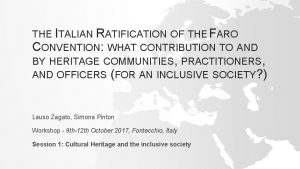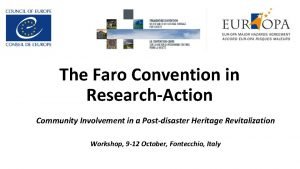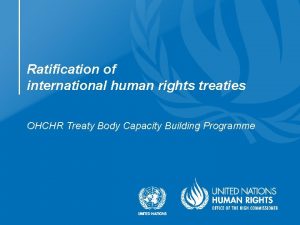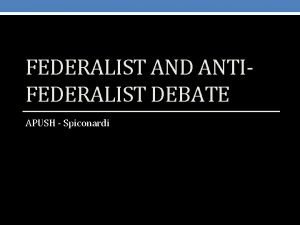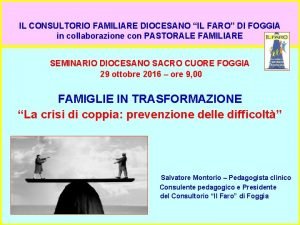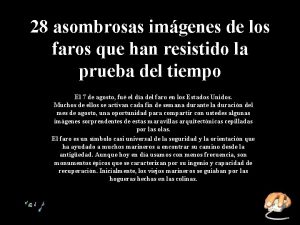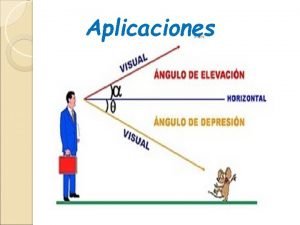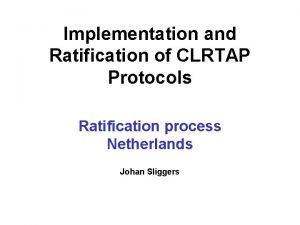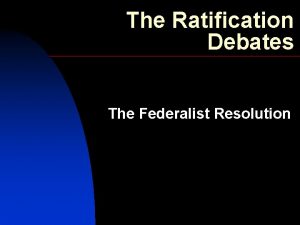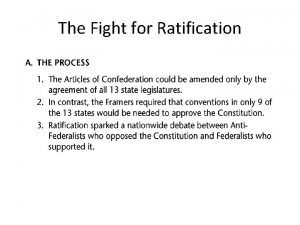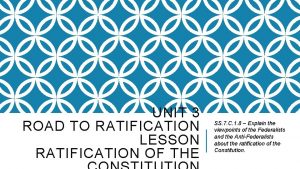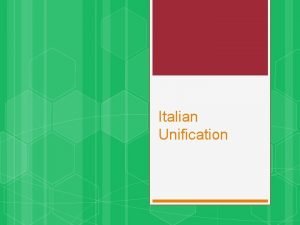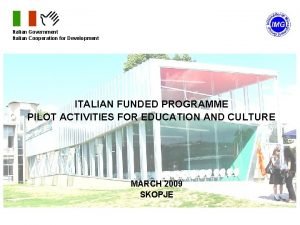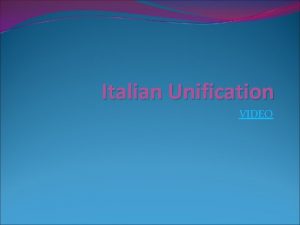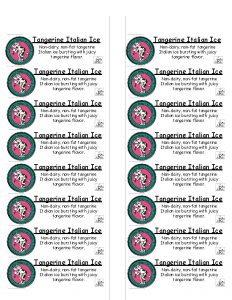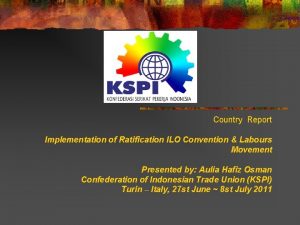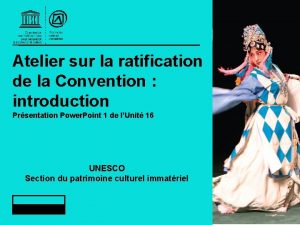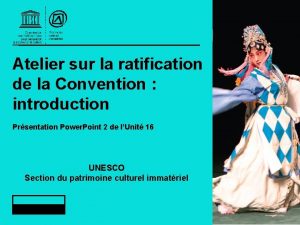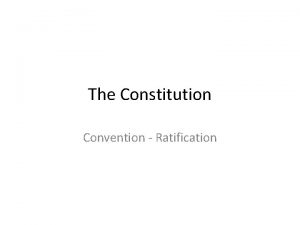THE ITALIAN RATIFICATION OF THE FARO CONVENTION WHAT




























- Slides: 28

THE ITALIAN RATIFICATION OF THE FARO CONVENTION: WHAT CONTRIBUTION TO AND BY HERITAGE COMMUNITIES, PRACTITIONERS, AND OFFICERS (FOR AN INCLUSIVE SOCIETY? ) Lauso Zagato, Simona Pinton Workshop - 9 th-12 th October 2017, Fontecchio, Italy Session 1: Cultural Heritage and the inclusive society

OUTLINE • The current scenario : Member States /Ratifications • The status of the Italian Draft Law before the Parliament • Peculiar (legal) features of the Faro Convention • Innivative notions • States’ undertakings once they have ratified • Sustainable use of CH (participation, democratic framework…. ) • Monitoring and Cooperation: On the legal nature of obligations and commitments in the Convention • The Venice case : the centrality of safeguarding traditional knowledge and a role for academia ?

THE CURRENT SCENARIO : MEMBER STATES /RATIFICATIONS • The Faro Convention on the Value of Cultural Heritage for Society (2005) has been ratified by 17 member states of the Council of Europe (Armenia, Austria, Bi. H, Croatia, Georgia, Hungary, Latvia, Luxemburg, Montenegro, Norway, Portugal, Republic of Moldova, Serbia, Slovak Republic, Slovenia, The former Yugoslav Republic of Macedonia, Ukraina), • and signed by 6 States (Albania, Belgium, Bulgaria, Finland, Italy, San Marino)

THE STATUS OF THE ITALIAN DRAFT LAW Twins Draft Laws on Ratification and implementation of the Council of Europe Framework Convention on the Value of Cultural Heritage for Society, Done at Faro, on the 27 th day of October 2005 presented: • • at the Chamber of Deputies, on 12 th May 2017, at the initiative of deputies Narduolo, Manzi, Rampi, Malisani. The draft law has been assigned on 6 June 2017 to III Committee International Affairs. Opinions delivered by the following Committee : I Affari Costituzionali, V Bilancio, VII Cultura, VIII Ambiente, XIV Politiche dell'Unione Europea e della Commissione parlamentare per le questioni regionali. At the Senate, at the initiatives of senators Ferrara, Puglisi, Idem, Martini, Tocci, Albano, Angioni, Bocchino, Cantini, Cardinali, Dalla Zuanna, Fabbri, Fasiolo, Favero, Filippin, Fissore, Lo Giudice, Lucherini, Manassero, Mattesini, Micheloni, Orellana, Orrù, Padua, Pezzopane, Puppato, Sangalli, Silvestro, Spilabotte, Tomaselli, Vaccari, Zanoni, D'adda E Pagliari. Favorable Opinions delivered by the following Committees: Foreign Affairs (end of August 2017), EU Policies (14 September 2017), Culture ( 20 September 2017) At the same time the Draft Law was communicated to the Presidency of the Council of Ministers on 12 April 2017, on 16 June 2017 the draft law has been presented to the Council of Minister, and then assigned to the Senate, where the legislative iter had already started on 12 May 2017. The text of the Draft Law: • Article 1 provides for the authorization to ratify the Convention. • Article 2 includes the order of executing the Convention. • Article 3 defines the financial coverage of the costs arising from the implementation of the law. • Article 4 defines its entry into force.

PECULIAR FEATURES OF THE FARO CONVENTION • Cultural Heritage as a human right • Faro Convention as a framework agreement • Faro Convention as an instrument of flexible nature

CH AS A HUMAN RIGHT Preamble, recital 4: Art. 1 a) Aims of the Convention: The Parties to this Convention agree to recognise that rights relating to cultural heritage are inherent in the right to participate in cultural life, as defined in the Universal Declaration of Human Rights; The member states of the Council of Europe, signatories hereto: (…) recognising that every person has a right to engage with the cultural heritage of their choice, while respecting the rights and freedoms of others, as an aspect of the right freely to participate in cultural life enshrined in the united nations universal declaration of human rights (1948) and guaranteed by the international covenant on economic, social and cultural rights (1966). • To be read in connection with art. 15 para. 1 a) of the Covenant on Economic, Social and Cultural Rights: «State Parties recognise the right of everyone to take part in cultural life. » Art. 4 c): The Parties recognise that …. b) everyone, alone or collectively, has the responsibility to respect the cultural heritage of others as much as their own heritage, and consequently the common heritage of Europe; c) the exercise of the right to cultural heritage may be subject only to those restrictions which are necessary in a democratic society for the protection of the public interest and the rights and freedoms of others. • To be read in connection with art. 5 c). The parties undertake to : ensure, in the specific context of each Party, that legislative provisions exist for exercising the right to cultural heritage as defined in Article 4.

A FRAMEWORK CONVENTION • A framework convention was chosen as the most appropriate type of legal instrument to develop a policy framework on CH at European level. • Framework conventions define broad objectives and identify areas for action, as well as the directions in which the Parties agree to progress. • Instruments of this type may identify generic activities but, unlike ordinary Conventions, do not create obligations to specific actions. This does not mean that they contain only non-binding provisions. It is open to Parties to choose the route most suited to their own national traditions of law, policy and practice, always taking into account the need to ensure that their own approaches are consistent with those of neighboring States and other Parties.

AN INSTRUMENT OF FLEXIBLE NATURE Due to its ‘flexible’ nature, as a consequence of being constructed around goals to be achieved, since time the Faro Convention goes through practical experimentation on a territorial scale, even by countries that have not yet ratified it (including our State). Faro Venezia, for example – El Felze?

INNOVATIVE NOTIONS IN FARO • Cultural Heritage • Common Heritage of Europe • Heritage Communities

CULTURAL HERITAGE • Art. 2 a): “Cultural heritage is a group of resources inherited from the past which people identify, independently of ownership, as a reflection and expression of their constantly evolving values, beliefs, knowledge and traditions. It includes all aspects of the environment resulting from the interaction between people and places through time”. • To be read in connection with Preamble recitals 2, 3: • Recognizing the need to put people and human values at the center of an enlarged and crossdisciplinary concept of cultural heritage; • Emphasizing the value and potential of cultural heritage wisely used as a resource for sustainable development and quality of life in a constantly evolving society.

COMMON HERITAGE OF EUROPE • Art. 3 a: The Parties agree to promote an understanding of the common heritage of Europe, which consists of: a) all forms of cultural heritage in Europe which together constitute a shared source of remembrance, understanding, identity, cohesion and creativity, and b) the ideals, principles and values, derived from the experience gained through progress and past conflicts, which foster the development of a peaceful and stable society, founded on respect for human rights, democracy and the rule of law • To be read in connection with Europe Landscape Convention (preamble 3). • Aware that the landscape contributes to the formation of local cultures and that it is a basic component of the European natural and cultural heritage, contributing to human well-being and consolidation of the European identity. •

HERITAGE COMMUNITIES • Art. 2 b): Heritage community consists of people who value specific aspects of cultural heritage which they wish, within the framework of public action, to sustain and transmit to future generations • The heritage community is defined in the absence of “societal parameters, national, ethnic, religious, professional or based on class” (G. Dolff-Bonekämper); • “The heritage only grows to the extent that new ‘mediators’ succeed in adding further heritage categories to a list that is hedged about by criteria selected in a far from diversified or consensual fashion by routine, prejudice and conflicts of power” (Leniaud).

ELIGIBILITY/AUTOELIGIBILITY OF HC • Unlike the communities called ‘natural’ by virtue of their belonging to a common ethnic or historical, or territorial group, being part of a heritage community means a modality of «aggregazione di collettività che mette in luce la natura costruita di ogni comunità i cui membri, dispersi su uno spazio che può essere transnazionale o discontinuo, riaffermano costantemente e volontariamente la loro adesione. » (Bortolotto) • the individual is brought back at the heart of a multicultural society that respects not only fundamental rights and freedoms but the cultural and social identity of individuals. • “In its widest sense, culture may now be said to be the whole complex of distinctive spiritual, material, intellectual and emotional features that characterize a society or social group. It includes not only the arts and letters, but also modes of life, the fundamental rights of the human being, value systems, traditions and beliefs” (UNESCO, World Conference on Cultural Policies, 1982).

STATES’ UNDERTAKINGS ONCE THEY HAVE RATIFIED (SELECTED IN ARTT. 1114) • • The necessity for involving all members of society in a rationale of democratic governance in all matters connected with the cultural heritage. In this, the governments of Parties and of their regions are seen as the leaders of a partnership process. States’ undertakings related to: - Public responsibilities for cultural heritage : to develop the legal, financial and professional frameworks which make possible joint action by public authorities, experts, owners, investors, businesses, nongovernmental organisations and civil society; to respect and encourage voluntary initiatives which complement the roles of public authorities; to encourage nongovernmental organisations concerned with heritage conservation to act in the public interest.

- Promoting access to cultural heritage : to encourage everyone to participate in the process of identification, study, interpretation, protection, conservation and presentation of the cultural heritage; of public reflection and debate on the opportunities and challenges which the cultural heritage represents; to recognise the role of voluntary organisations both as partners in activities and as constructive critics of cultural heritage policies; to take steps to improve access to the heritage, especially among young people and the disadvantaged, in order to raise awareness about its value, the need to maintain and preserve it and the benefits which may be derived from it. - Promoting the knowledge of CH : to facilitate the inclusion of the cultural heritage dimension at all levels of education, as a fertile source for studies in other subjects; to strengthen the link between cultural heritage education and vocational training; to encourage interdisciplinary research on cultural heritage, heritage communities, the environment and their inter-relationship; to encourage continuous professional training and the exchange of knowledge and skills. - CH and the information society : to develop the use of digital technology to enhance access to cultural heritage and the benefits which derive from it.

SUSTAINABLE USE OF CH AND SUSTAINABILITY OF CH (PARTICIPATION, DEMOCRATIC FRAMEWORK, INCLUSIVE SOCIETY…. ) • Implement “shared responsibility” principle, involving citizens and civil society in mechanisms integrated with public action in order to identify values, define priorities and manage heritage-led projects (Articles 5 c, 5 d, 11 e, 12 a and 12 c). • Link to Sustainable Development Goal 16: Promoting peaceful and inclusive [knowledge] societies

WHY TO REASON ON CULTURE, CULTURAL HERITAGE, SUSTAINABILITY? • To define, also in the international law context, of a notion of cultural sustainability • To reconstruct the most advances practices and experiences, at international level, of safeguarding and valorization of traditional knowledge, and to foster the exchange of these practices • To produce “inspirational models” for policy-makers in charge to develop and design specific implementation policies capable of supporting and developing artisan skills and traditional cultural competencies

VALUES AND RISKS OF PARTICIPATION • Encourage a sense of responsibility in all social stakeholders so that they act on the basis of feeling they belong to a community which is enriched by its diversity (Articles 8 c, 9 b, 9 d). • But: a) Governance issues on cultural heritage emerge: - the diversity of political and social actors involved - different spaces - redefining and renewing the nature of relations between political power, public institutions, public entities and heritage communities b) Issue of the quality of choices: “Usually governments are responsible for the recognition of significant heritage in lists and registers, but they are not always the leaders in creating significance […]. At local (sub-national) level […] communities also have their own sense of what is significant” (Logan, 2012) c) The question of sustainability: availability of adequate human, financial, and organizational resources for research, identification of documentation and recognition of cultural heritage

BOTTOM-UP APPROACH IN THE IMPLEMENTATION OF FARO • Actions aimed at promoting the knowledge of the Faro Convention and at encouraging member States to sign and ratify the Convention: • - Faro talks, Faro meetings and Faro lab. • - Faro Convention Workshops • - Faro Applications: Heritage committee; Heritage walk; Residents’ co-operative; Mapping Faro - Convention initiatives • - A network of Faro Cities • The Charter of Venice: an example of local bottom-up practice

INCLUSIVE SOCIETY • All bottom up initiatives promote social cohesion and inclusivity • The Convention calls: - to determine the public interest in heritage in order to stimulate the right investment for preserving and enhancing the social and economic value of the different kinds of heritage (Articles 5 a, 5 b and 10 a). - to promote conciliation and reconciliation in order to bring together within a community the stakeholders who are defending divergent interests, and to allow dialogue to become one of the main forces for sustainable development (Articles 5 f, 7 a, 7 b and 7 c). -to bring together the objectives related to economic efficiency, social cohesion and ecological balance within heritage- led strategies that allow for the combined action of public authorities, investors and civil society (Articles 5 g, 8 a, 8 b, 9 a, 10 b, 10 c, 11 a, 11 b, and 11 c). • Cultural heritages are resources on which to develop dialogue, democratic debate and openness between cultures.

MONITORING AND COOPERATION : ON THE LEGAL NATURE OF OBLIGATIONS AND COMMITMENTS IN THE CONVENTION An original approach is sets out on how the Parties are expected to work together towards the Convention’s objectives, laying particular stress upon monitoring of progress as the source of priorities for collaborative action.

MONITORING Art. 15. Undertakings of the Parties The Parties undertake to: a) develop, through the Council of Europe, a monitoring function covering legislations, policies and practices concerning cultural heritage, consistent with the principles established by this Convention; b) maintain, develop and contribute data to a shared information system, accessible to the public, which facilitates assessment of how each Party fulfils its commitments under this Convention. Art. 16 Monitoring and cooperation mechanisms - The Committee of Ministers, pursuant to Article 17 of the Statute of the Council of Europe, shall nominate an appropriate committee or specify an existing committee to monitor the application of the Convention, which will be authorised to make rules for the conduct of its business; - The nominated committee shall: • establish rules of procedure as necessary; • manage the shared information system referred to in Article 15, maintaining an overview of the means by which each commitment under this Convention is met; • at the request of one or more Parties, give an advisory opinion on any question relating to the interpretation of the Convention, taking into consideration all Council of Europe legal instruments; • on the initiative of one or more Parties, undertake an evaluation of any aspect of their implementation of the Convention; • foster the trans-sectoral application of this Convention by collaborating with other committees and participating in other initiatives of the Council of Europe; • report to the Committee of Ministers on its activities. • The committee may involve experts and observers in its work. •

THE VENICE CASE : THE CENTRALITY OF SAFEGUARDING TRADITIONAL KNOWLEDGE HERITAGE WALKS, HERITAGE COMMUNITIES AND A ROLE FOR ACADEMIA?

ON HERITAGE WALKS AND BEYOND A Heritage Walk is conceived by and with those who live and work in a territory or have a special affinity with it. The walk is devised by combining the stories of all the participants in the context of research work drawing on scientific sources and also on the life experiences of local residents, on the discovery of local curiosities and on the accumulated knowledge of the places concerned. Such a walk can take many forms with the aim of experiencing, documenting and living a territory in unusual ways: guided tours run by heritage communities, sensitive walks run by artists, walks run by authors and visits to the homes of residents in their own neighbourhoods (from Faro Free Applications, Co. E, at https: //rm. coe. int/16806 abe 1 c A Heritage Walk is conceived and planned by citizens acting as “Heritage Community”; is based on a meaningful topic; a central thread connecting palces and people; its topic is often “cultural” in a broad sense, involving industrial areas, suburbs an others places not included in mass turism; usually it opens private places with the cooperation of their actual owners; has not a professional guide, but is focused on meeting testimonials; usually it is free of charge. It can also be founded by public or private bodies as project of general interest (from Faro Venezia, at https: //farovenezia. org/azioni/lepasseggiate-patrimoniali)

HERITAGE WALKS DIFFERENT FROM CULTURAL ROUTES BUT CAN WE THINK OF HERITAGE WALKS AS A FORM OF IDENTITARIAN REAPPROPRIATION BY HERITAGE COMMUNITIES?

ON THE VENETIAN EXPERIENCE TRADITIONAL CRAFTMANSHIP HISTORY STERILIZATION

A POSSIBLE ROLE FOR THE ‘ACADEMICS’ IN THE FIELD? • The problematic relationship between traditional knowledge and “saper fare”, on one side and its safeguarding, also as commons, opens the way to a high-level research on the protection of the TK. • More than any other place in Europe, Venice is the right workspace for carrying on this research. • Is it valuable to promote an intellectual co-operation to the benefit of local communities, also by establishing an «intellectual service structure» ?

THANK YOU! Lzagato@unive. it pinton@unive. it
 Faro convention
Faro convention Faro
Faro Explain ratification of a pre incorporation contract
Explain ratification of a pre incorporation contract Ratification
Ratification Iccpr ratification
Iccpr ratification Ratification debate apush
Ratification debate apush Consultorio familiare foggia
Consultorio familiare foggia Faro de tevennec
Faro de tevennec Lisa faro
Lisa faro Una persona se encuentra a 10m del pie de un faro
Una persona se encuentra a 10m del pie de un faro Faro shuffle java
Faro shuffle java Lời thề hippocrates
Lời thề hippocrates Dot
Dot Bổ thể
Bổ thể Vẽ hình chiếu đứng bằng cạnh của vật thể
Vẽ hình chiếu đứng bằng cạnh của vật thể Phản ứng thế ankan
Phản ứng thế ankan Các môn thể thao bắt đầu bằng tiếng nhảy
Các môn thể thao bắt đầu bằng tiếng nhảy Sự nuôi và dạy con của hổ
Sự nuôi và dạy con của hổ điện thế nghỉ
điện thế nghỉ Nguyên nhân của sự mỏi cơ sinh 8
Nguyên nhân của sự mỏi cơ sinh 8 Một số thể thơ truyền thống
Một số thể thơ truyền thống Trời xanh đây là của chúng ta thể thơ
Trời xanh đây là của chúng ta thể thơ Gấu đi như thế nào
Gấu đi như thế nào Thiếu nhi thế giới liên hoan
Thiếu nhi thế giới liên hoan Thế nào là số nguyên tố
Thế nào là số nguyên tố Tỉ lệ cơ thể trẻ em
Tỉ lệ cơ thể trẻ em Tia chieu sa te
Tia chieu sa te Các châu lục và đại dương trên thế giới
Các châu lục và đại dương trên thế giới Thế nào là hệ số cao nhất
Thế nào là hệ số cao nhất
